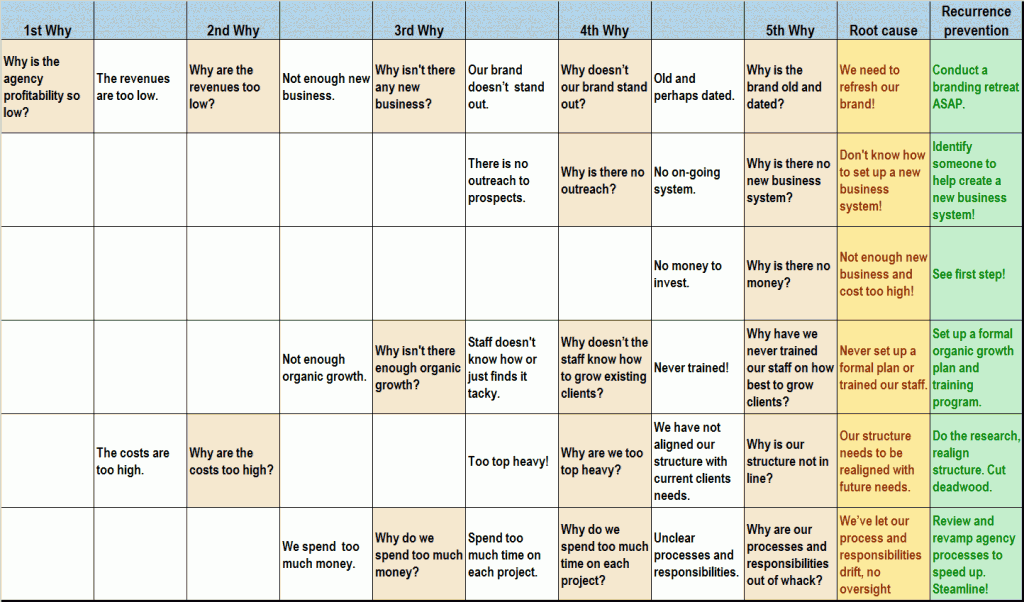The other day an interesting conversation reminded me of the old consulting tool called the “5 Whys.”
It’s a simple question-asking method used to explore the cause/effect relationships underlying a particular problem. Ultimately, the goal of applying the “5 Whys” method is to determine a root cause of a defect or problem. The basic concept is if you ask “why” five times you will get to the root cause of any issue.
A more complex problem solving process is called the “Why-Why Analysis,” used to help analyze the context in which you operate, how you are moving on the market, how to meet client needs and much more. In other words, you can better analyze if you are moving in the wrong way (and therefore have to change something), or if you are operating in the right way.
Running a Why-Why Analysis.
You start by stating the problem and listing out why that problem has occurred. Once all the major reasons for the problem have been clearly identified, each of the major reasons is taken in turn and again “why” is asked. Then you list out all the major reasons why those issues have occurred, and so on. By doing so, we create a question chain, often one that ends with the identification of the root problem.
Leading the Why-Why Session:
This session is best run if the team pre-selects a problem that it wishes to address. This problem solving tool works best with higher level problems such as: we don’t meet deadlines, our costs are too high, we make too many mistakes, etc…
Place two flip-chart pages on the wall in front of the team. The pages should be placed vertically next to each other. When facing the flip-chart pages, write the problem statement in the middle of the left page. This is more effective if you’ve done the leg work to clearly define the problem. As Charles Kettering well stated, “A problem thoroughly understood is always fairly simple. Found your opinions on facts, not prejudices. We know too many things that are not true.” This holds true for this exercise.
Next, draw the first branch of the diagram. Ask the team to name the basic reasons why the problem occurs and list those as the primary causes on the first branch. There should be between five and ten first-level causes. Challenge the team to think out-of-the-box if they can only identify one or two primary causes.
The next step is to move to the next level. Ask the question “Why?” for each secondary cause. The chart will start to get large and complex. You can see how complex this is getting; all of the items on the chart are potential causes. Even if you addressed half of these, the problem would recur. Therefore, a holistic approach like this one is important.
The chart should be taken to three or four levels (branches). It is up to the team to determine how far to take it. You will know that you can stop when you feel comfortable that you have determined the root causes. There is no magic rule here. It is critical that you identify true root causes or you will not eliminate problems. When in doubt, ask “Why?” again.
A Very Simple Agency Example:
Remember: We must remove root causes of the problem or they will recur. If you have the flu and it’s causing a headache, you may take some aspirin to relieve the headache. But you are not addressing the root cause. Unless you take something to eliminate the flu (the root cause) the headache will probably recur. The same holds true in work situations.
This chart will not solve the problem or “give” the answer. It is the first step in a lengthy process. However, without going through this process, most problems will not go away. Put the time in up front, and in the long run, you will save a lot of time.
The next step is to go through the list of root causes and try to identify those that you would like to start eliminating. Criteria for this should include:
- Cause most likely to be having the most significant impact on the problem (look for causes that show-up on more than one branch of the chart). The more times a cause is listed, the more likely that it is significant.
- Try to prioritize causes so that you can get some “quick wins” early. Be prepared to spend a lot of time on more significant (high level) causes.
- Spend your energy trying to resolve those causes that you can control.
Make Problem Solving Effective.
Start with a good mix of people in the room. Often someone will be too close, or someone can be too senior. It helps to have those that are familiar with the process and the problem in the room so they are able to answer why something happened. It is also helpful to have someone with a fresh eye participate – often they ask questions that help those involved in the problem extract the real reasons something happened.
Just as important is to always avoid playing the blame game. Keep your focus on finding systemic problems. You are looking for systematic solutions to the problem, not pointing fingers or blaming a department.
Remember to look for “hidden whys,” what we call the in-between the whys. This is a great tool to help re-define the problem. Study two consecutive whys and try to complete the sentence: “The first why contributes to the second why because…” Focusing on the empty space between the first and second whys will often lead you to discovering a hidden one – and perhaps a root cause.
No matter how your problem solving session goes, take a moment to debrief with the team. Sometimes the discussion will naturally leap to one or more possible solutions not considered.
People are often surprised by the difficulty of pushing themselves (occasionally people can get exasperated by the repeated “whys”). Most often, though, people are pleasantly surprised by where their thinking takes them. The point of any problem solving exercise is to examine a question and solve it once and for all, so keep an open mind and give it a try.
Photo by ~alvaramorrigan



